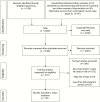Risk of Early-Onset Neonatal Group B Streptococcal Disease With Maternal Colonization Worldwide: Systematic Review and Meta-analyses
- PMID: 29117325
- PMCID: PMC5850448
- DOI: 10.1093/cid/cix655
Risk of Early-Onset Neonatal Group B Streptococcal Disease With Maternal Colonization Worldwide: Systematic Review and Meta-analyses
Abstract
Background: Early-onset group B streptococcal disease (EOGBS) occurs in neonates (days 0-6) born to pregnant women who are rectovaginally colonized with group B Streptococcus (GBS), but the risk of EOGBS from vertical transmission has not been systematically reviewed. This article, the seventh in a series on the burden of GBS disease, aims to estimate this risk and how it varies with coverage of intrapartum antibiotic prophylaxis (IAP), used to reduce the incidence of EOGBS.
Methods: We conducted systematic reviews (Pubmed/Medline, Embase, Latin American and Caribbean Health Sciences Literature (LILACS), World Health Organization Library Information System [WHOLIS], and Scopus) and sought unpublished data from investigator groups on maternal GBS colonization and neonatal outcomes. We included articles with ≥200 GBS colonized pregnant women that reported IAP coverage. We did meta-analyses to determine pooled estimates of risk of EOGBS, and examined the association in risk of EOGBS with IAP coverage.
Results: We identified 30 articles including 20328 GBS-colonized pregnant women for inclusion. The risk of EOGBS in settings without an IAP policy was 1.1% (95% confidence interval [CI], .6%-1.5%). As IAP increased, the risk of EOGBS decreased, with a linear association. Based on linear regression, the risk of EOGBS in settings with 80% IAP coverage was predicted to be 0.3% (95% CI, 0-.9).
Conclusions: The risk of EOGBS among GBS-colonized pregnant women, from this first systematic review, is consistent with previous estimates from single studies (1%-2%). Increasing IAP coverage was linearly associated with decreased risk of EOGBS disease.
Keywords: Streptococcus agalactiae; group B Streptococcus; neonatal sepsis; risk; vertical transmission.
© The Author 2017. Published by Oxford University Press for the Infectious Diseases Society of America.
Figures




References
-
- Baker CJ, Barrett FF. Transmission of group B streptococci among parturient women and their neonates. J Pediatr 1973; 83:919–25. - PubMed
-
- Baker CJ, Barrett FF, Yow MD. The influence of advancing gestation on group B streptococcal colonization in pregnant women. Am J Obstet Gynecol 1975; 122:820–3. - PubMed
-
- Baker CJ, Webb BJ, Kasper DL, Yow MD, Beachler CW. The natural history of group B streptococcal colonization in the pregnant woman and her offspring. II. Determination of serum antibody to capsular polysaccharide from type III, group B Streptococcus. Am J Obstet Gynecol 1980; 137:39–42. - PubMed
Publication types
MeSH terms
Grants and funding
LinkOut - more resources
Full Text Sources
Other Literature Sources
Medical
Research Materials

